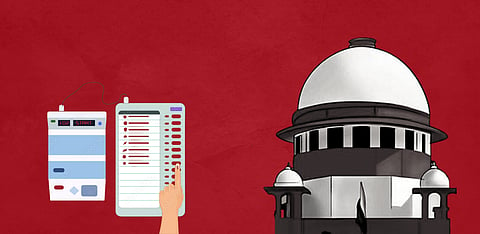

While admitting that the petitioner's concern may be too suspicious, the Supreme Court has sought response from the Election Commission of India in a plea seeking to cross-verify electronic voting machines vote count with that of VVPAT.
—
ON Monday, the Supreme Court asked the Election Commission of India (ECI) to respond to a public interest litigation (PIL) by a non-governmental organisation (NGO), Association of Democratic Reforms (ADR), demanding a direction to the ECI that counts from electronic voting machines (EVMs) and voter-verifiable paper audit trail units should be tallied with each other.
Currently, only around 2 percent of EVM counts are matched with VVPAT. A Bench comprising Justices Sanjiv Khanna and Bela M. Trivedi asked the petitioner to serve a copy of their petition to the counsel for the ECI.
The Bench, however, cautioned the petitioner against being "oversuspicious".
"Mismatch between EVMs, VVPAT and register entries at a polling booth could happen because of a mix of factors. There are times when people sign in to the register and enter the poll booths but do not press the EVM. There could be similar other reasons," the Bench added.
Advocate Prashant Bhushan, appearing on behalf of the ADR, argued that although he also believes that EVMs could not be tampered with or hacked, certain procedural changes are required which could accord more credibility to the system.
The petition argues that it is the satisfaction and verification of the voter that is at the heart of electoral democracy and not just that of the ECI, domain experts, political parties or the candidates.
"'Voter verifiable' means that each voter must be able to verify: firstly, that their vote has been recorded as cast; and, secondly, that their vote has been counted as recorded," the petition avers.
The petition adds that the requirement of the voter to verify that their vote has been recorded as cast is somewhat met when the VVPAT slip is displayed for about seven seconds through a transparent window after pressing the button on the EVM.
This gives time to the voter to verify that their vote has been recorded as cast on the internally printed VVPAT slip before the slip falls into a ballot box.
The petition asserts that there is a complete vacuum in the law and the ECI has failed to provide a procedure to verify that a voter's vote has been counted as recorded, which is an indispensable part of voter verifiability.
The petition states that this may be because the voter is not given a copy of the printout of her VVPAT.
Giving the example of the 2019 general elections, the petition also states that there were ECI-acknowledged instances wherein there was variance in the results captured in the EVMs and that of the VVPATs.
"To illustrate, during mandatory verification of paper slips of VVPAT of five randomly selected polling stations, in polling station no. 63 of Mydukur assembly constituency in Andhra Pradesh in the 2019 general elections, the returning officer officially verified that there was a discrepancy of 14 votes in the EVM and VVPAT counts.
"The EVM count was 233 votes whereas the VVPAT count was 219 votes. In other words, 6 percent of the counted votes in that EVM had not been cast. The returning officer of the constituency later clarified that the discrepancy is true and was due to non-clearance of votes polled in the mock poll conducted at 7 a.m. on the polling day from the EVM," the petition reads.
On the basis of this illustration, the petition argues that counts stored in EVMs are inherently open to variance with the counts reflected in VVPATs.
This, the petition contends, may be due to a number of reasons such as bonafide human errors in the complex seriatim of do's and don'ts prescribed by the ECI involving a number of individuals to discharge their responsibilities with 100 percent accuracy.
These individuals are required to maintain accuracy each time, over a long period of time without any technical snags or malafide actions.
The petitioner thus requests the Supreme Court to direct the ECI to ensure that the voters are able to verify through VVPATs that their vote has been counted as recorded.